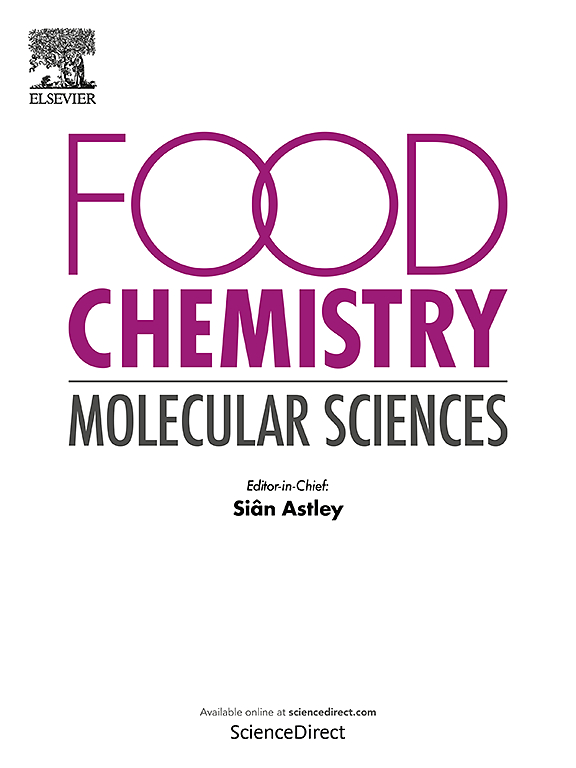Exploring microbial dynamics and metabolomic profiling of isoflavone transformation in black and yellow soybean tempe for sustainable functional foods
IF 4.7
Q2 FOOD SCIENCE & TECHNOLOGY
引用次数: 0
Abstract
Tempe, a traditional Indonesian fermented food, is rich in bioactive isoflavones and peptides, offering significant health benefits. This study explores how fermentation methods and soybean varieties shape isoflavone profiles and microbial communities. Two fermentation approaches were compared: Raprima™ starter culture and a co-culture of Rhizopus oligosporus and R. stolonifer. Metabolomic analysis showed that co-culture fermentation significantly increased genistein levels and enhanced isoflavone bioavailability. Proteobacteria (78 %) and Firmicutes (18 %) dominated bacterial communities, with yellow soybeans containing more Enterobacteriaceae. Co-culture fermentation enriched Stenotrophomonas, while Raprima™ favored Acinetobacter. The fungal community, primarily Mucoromycota (92 %), exhibited significant correlations with isoflavone transformation. Co-culture fermentation improved microbial synergy and metabolic efficiency, boosting isoflavone aglycone production. While yellow soybeans had higher isoflavone content, black soybeans, with elevated genistein, present a promising alternative. These findings emphasize fermentation's role in enhancing tempe's functionality for sustainable, nutritionally rich food development.
可持续功能食品中大豆异黄酮转化的微生物动力学和代谢组学分析
丹贝是一种传统的印尼发酵食品,富含生物活性异黄酮和多肽,对健康有益。本研究探讨了发酵方法和大豆品种如何形成异黄酮谱和微生物群落。比较了两种发酵方法:Raprima™发酵剂培养和少孢根霉与匍匐茎霉的共培养。代谢组学分析表明,共培养发酵显著提高了染料木素水平,提高了异黄酮的生物利用度。变形菌门(78%)和厚壁菌门(18%)的细菌群落占主导地位,黄豆含有较多的肠杆菌科。共培养发酵富集窄养单胞菌,而Raprima™有利于不动杆菌。真菌群落,主要是Mucoromycota(92%),表现出与异黄酮转化显著相关。共培养发酵提高了微生物协同作用和代谢效率,促进了异黄酮苷元的生产。黄大豆异黄酮含量较高,而染料木素含量较高的黑大豆是一个有希望的替代品。这些发现强调了发酵在增强teme功能方面的作用,以实现可持续的、营养丰富的食品开发。
本文章由计算机程序翻译,如有差异,请以英文原文为准。
求助全文
约1分钟内获得全文
求助全文
来源期刊

Food Chemistry Molecular Sciences
Agricultural and Biological Sciences-Food Science
CiteScore
6.00
自引率
0.00%
发文量
83
审稿时长
82 days
期刊介绍:
Food Chemistry: Molecular Sciences is one of three companion journals to the highly respected Food Chemistry.
Food Chemistry: Molecular Sciences is an open access journal publishing research advancing the theory and practice of molecular sciences of foods.
The types of articles considered are original research articles, analytical methods, comprehensive reviews and commentaries.
Topics include:
Molecular sciences relating to major and minor components of food (nutrients and bioactives) and their physiological, sensory, flavour, and microbiological aspects; data must be sufficient to demonstrate relevance to foods and as consumed by humans
Changes in molecular composition or structure in foods occurring or induced during growth, distribution and processing (industrial or domestic) or as a result of human metabolism
Quality, safety, authenticity and traceability of foods and packaging materials
Valorisation of food waste arising from processing and exploitation of by-products
Molecular sciences of additives, contaminants including agro-chemicals, together with their metabolism, food fate and benefit: risk to human health
Novel analytical and computational (bioinformatics) methods related to foods as consumed, nutrients and bioactives, sensory, metabolic fate, and origins of foods. Articles must be concerned with new or novel methods or novel uses and must be applied to real-world samples to demonstrate robustness. Those dealing with significant improvements to existing methods or foods and commodities from different regions, and re-use of existing data will be considered, provided authors can establish sufficient originality.
 求助内容:
求助内容: 应助结果提醒方式:
应助结果提醒方式:


